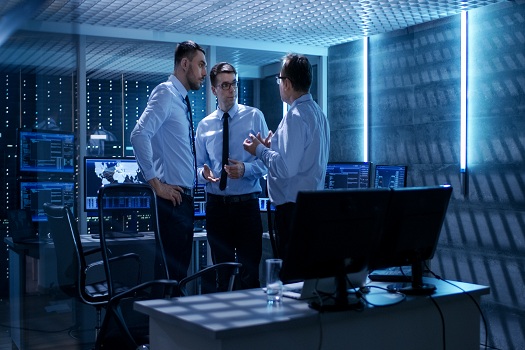Navigating the World of Corporate Security: Secret Insights and Finest Practices
Wiki Article
From Cybersecurity to Physical Actions: Enhancing Company Security in a Transforming World
By incorporating the toughness of both cybersecurity and physical security, companies can create a comprehensive defense method that attends to the diverse range of risks they encounter. In this conversation, we will certainly check out the altering hazard landscape, the requirement to incorporate cybersecurity and physical safety and security, the execution of multi-factor authentication measures, the importance of staff member recognition and training, and the adjustment of protection procedures for remote workforces. By analyzing these essential areas, we will certainly get valuable insights right into exactly how organizations can strengthen their corporate security in an ever-changing globe.Understanding the Changing Threat Landscape
The evolving nature of the contemporary world demands a comprehensive understanding of the transforming risk landscape for reliable business safety. In today's interconnected and electronic age, hazards to business safety and security have actually ended up being more intricate and advanced. As technology breakthroughs and services become significantly reliant on electronic infrastructure, the potential for cyberattacks, information breaches, and various other security violations has actually substantially increased. It is vital for companies to stay educated and adapt their safety and security gauges to deal with these progressing threats.One key aspect of understanding the changing threat landscape is identifying the various kinds of dangers that companies encounter. Furthermore, physical dangers such as theft, vandalism, and company reconnaissance stay prevalent concerns for businesses.
Surveillance and examining the danger landscape is vital in order to determine potential threats and susceptabilities. This involves remaining upgraded on the most recent cybersecurity trends, assessing danger intelligence records, and carrying out regular threat evaluations. By understanding the transforming danger landscape, organizations can proactively apply ideal protection procedures to reduce threats and secure their assets, online reputation, and stakeholders.
Integrating Cybersecurity and Physical Safety
Integrating cybersecurity and physical protection is important for comprehensive company protection in today's electronic and interconnected landscape. As companies progressively rely upon innovation and interconnected systems, the limits in between physical and cyber risks are becoming blurred. To properly protect versus these risks, an alternative approach that integrates both cybersecurity and physical protection steps is crucial.Cybersecurity focuses on securing digital assets, such as systems, data, and networks, from unapproved access, interruption, and burglary. Physical security, on the other hand, includes procedures to safeguard physical assets, people, and facilities from vulnerabilities and dangers. By incorporating these two domains, organizations can attend to susceptabilities and hazards from both physical and digital angles, thus improving their general protection posture.
The integration of these two disciplines permits a much more comprehensive understanding of security risks and allows a unified action to occurrences. As an example, physical gain access to controls can be improved by incorporating them with cybersecurity procedures, such as two-factor authentication or biometric identification. Similarly, cybersecurity procedures can be matched by physical protection actions, such as monitoring video cameras, alarms, and secure accessibility factors.

Implementing Multi-Factor Verification Actions
As organizations progressively focus on comprehensive safety and security procedures, one reliable method is the application of multi-factor verification procedures. Multi-factor authentication (MFA) is a security technique that needs customers to provide multiple types of have a peek at these guys identification to access a system or application. This technique includes an added layer of protection by combining something the individual understands, such as a password, with something they have, like a finger print or a protection token.By implementing MFA, companies can significantly improve their safety pose - corporate security. Traditional password-based verification has its limitations, as passwords can be quickly jeopardized or forgotten. MFA minimizes these threats by including an added verification factor, making it much more challenging for unauthorized individuals to get access to sensitive info
There are several sorts of multi-factor authentication approaches offered, including biometric authentication, SMS-based confirmation codes, and hardware symbols. Organizations require to evaluate their certain needs and pick one of the most appropriate MFA service for their needs.
Nonetheless, the application of MFA should be carefully planned and implemented. It is vital to strike a balance between protection and use to stop customer frustration and resistance. Organizations needs to also consider prospective compatibility issues and give appropriate training and support to make certain a smooth shift.
Enhancing Employee Awareness and Training
To reinforce business security, companies should focus on enhancing staff member awareness and training. In today's swiftly developing hazard landscape, workers play an essential duty in safeguarding a company's sensitive info and properties. Many safety and security violations occur due to human error or absence of recognition. For that reason, companies require to buy detailed training programs to enlighten their employees regarding possible threats and the very best techniques for mitigating them.Effective employee recognition and training programs should cover a large range of topics, including data protection, phishing assaults, social engineering, password hygiene, and physical safety and security procedures. These programs must be customized to the certain requirements and obligations of different worker roles within the organization. Regular training simulations, sessions, and workshops can aid staff members establish the needed skills and knowledge to identify and react to safety and security risks efficiently.
In addition, companies ought to urge a culture of security recognition and offer recurring updates and tips to keep workers informed concerning the newest threats and reduction techniques. This can be done with internal interaction channels, such as e-newsletters, intranet portals, and e-mail campaigns. By promoting a security-conscious workforce, organizations can significantly minimize the likelihood of safety look at more info incidents and secure their valuable possessions from unapproved access or concession.

Adapting Security Measures for Remote Workforce
Adjusting company safety and security procedures to suit a remote workforce is vital in making certain the defense of delicate details and assets (corporate security). With the increasing trend of remote work, organizations should execute suitable safety and security procedures to alleviate the dangers related to this brand-new method of workingOne important element of adapting safety and security steps for remote work is establishing secure interaction networks. Encrypted messaging systems and online private networks (VPNs) can help protect delicate details and stop unauthorized gain access to. article Additionally, organizations need to apply using strong passwords and multi-factor verification to improve the safety and security of remote access.
Another vital factor to consider is the application of secure remote accessibility remedies. This entails supplying employees with secure access to company sources and data via digital desktop facilities (VDI), remote desktop methods (RDP), or cloud-based options. These innovations ensure that delicate info continues to be secured while enabling staff members to perform their duties efficiently.

Last but not least, extensive safety understanding training is critical for remote employees. Training sessions ought to cover ideal techniques for firmly accessing and handling sensitive information, identifying and reporting phishing attempts, and maintaining the overall cybersecurity hygiene.
Conclusion
In conclusion, as the hazard landscape proceeds to develop, it is crucial for companies to enhance their security gauges both in the cyber and physical domains. Incorporating cybersecurity and physical safety, executing multi-factor authentication measures, and boosting worker awareness and training are crucial steps in the direction of accomplishing robust business security.In this conversation, we will check out the changing danger landscape, the need to incorporate cybersecurity and physical security, the application of multi-factor authentication procedures, the importance of worker recognition and training, and the adaptation of protection steps for remote labor forces. Cybersecurity measures can be matched by physical protection steps, such as security cameras, alarms, and safe and secure access points.
As companies increasingly prioritize detailed security steps, one efficient strategy is the implementation of multi-factor authentication procedures.In verdict, as the risk landscape continues to progress, it is crucial for organizations to enhance their protection measures both in the cyber and physical domains. Integrating cybersecurity and physical safety, applying multi-factor verification steps, and improving worker understanding and training are crucial actions towards attaining durable company security.
Report this wiki page